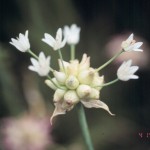Wild Onion
Allium spp.
Liliaceae (Lily family)
Description
There are 14 species and several varieties of wild onions in Texas. These biennial or perennial herbs have strong-scented (odor of garlic/onion), underground bulbs that give rise to long, narrow leaves. The flowers are arranged in a terminal cluster attached to an unbranched stalk arising from the bulb between the leaves. Flower stalks range from 6 to 20 inches or 15 to 51 cm high with blooms of white, yellow, pink, red, or purple. In some species, blooms are replaced by bulblets.Habitat
Wild Onions are widely distributed across the United States and are found during the spring in every region of Texas and in virtually every soil type.Toxic Agent
Onions contain N-propyl disulfide, which destroys red blood cells. Cultivated onions contain the same toxin and are often used as livestock feed. Consuming many onions is usually required to cause poisoning: often pastures containing onions are heavily grazed without problems. The amount of toxins in the plants varies based on factors that are not well understood. Cattle and horses are susceptible to onion poisoning, and cats are very sensitive to it. Sheep are more resistant but have been poisoned by onions in some instances.Signs of Livestock Ingestion
Acute signs usually develop after a long-term intake of the plants and include:- Jaundice (yellowish mucous membranes)
- Depression
- Anorexia
- Weakness
- Dark red or brown urine
Management Strategies
Most onion poisoning occurs when animals are fed waste onions. However, some cases occur when cattle or horses are forced to consume large amounts of wild onions. Good range management with adequate forage production will prevent Wild Onion poisoning.Images
Plant Characteristics
Flower Color: Pink, Purple, Red, White, Yellow
Seed Type: Fruit/Berry
Duration: Biennial, Perennial
Stem Texture: Hairless/Smooth
Growth Habit: Forbs/Broadleaf
Leaf Shape
 : Simple with Pinnate or Parallel Venation
: Simple with Pinnate or Parallel Venation
Season: Warm
Distribution
 : 01 - Pineywoods, 02 - Gulf Prairies and Marshes, 03 - Post Oak Savannah, 04 - Blackland Prairies, 05 - Cross Timbers and Prairies, 06 - South Texas Plains, 07 - Edwards Plateau, 08 - Rolling Plains, 09 - High Plains, 10 - Trans-Pecos
: 01 - Pineywoods, 02 - Gulf Prairies and Marshes, 03 - Post Oak Savannah, 04 - Blackland Prairies, 05 - Cross Timbers and Prairies, 06 - South Texas Plains, 07 - Edwards Plateau, 08 - Rolling Plains, 09 - High Plains, 10 - Trans-Pecos
Distributions
Distribution refers to the ecological region in Texas that a plant has been found. You can also view a clickable map.
Book: Toxic Plants of Texas (B-6105)
Collection: Toxics, Wild Flowers
Livestock Affected: Cattle, Horses, Sheep
Livestock Signs: Abnormal Urination, Anorexia, Depression/ Weakness, Jaundice (yellowish mucous membranes)





